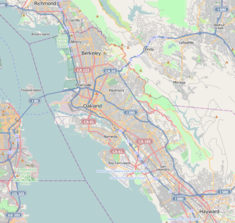Emeryville Shellmound
| Site of Shell Mound | |
|---|---|

Shellmound and dance pavilion, in 1902
|
|
| Location | 4600 block of Shell Mound St., Emeryville, California |
| Coordinates | 37°50′02″N 122°17′33″W / 37.834°N 122.29263°WCoordinates: 37°50′02″N 122°17′33″W / 37.834°N 122.29263°W |
| Reference no. | 335 |
The Emeryville Shellmound, in Emeryville, California, is a sacred burial site of the Ohlone people, a once-massive archaeological shell midden deposit (dark, highly organic soil, temple and burial ground containing a high concentration of human food waste remains, including shellfish). It was one of a complex of five or six mounds along the mouth of the perennial Temescal Creek, on the east shore of San Francisco Bay between Oakland and Berkeley. It was the largest of the over 425 shellmounds that surrounded San Francisco Bay.
From 800B.C. groups of Native Americans called the Ohlone or Costanoans lived at this spot by the Bay. The Bay Area region was divided into several dialect-speaking groups, the most advanced society among them called the Chochenyans who resided in the Alameda county region. Emeryville was believed to have been their capital. Originally reported as over 60 feet (18 m) high and some 350 feet (110 m) in diameter, the shellmound constituted a small hill, and was physically linked to several adjacent mounds by extensive lower-lying midden deposits. Its peak likely provided sweeping views of the Bay and the Golden Gate.
Archaeologists believe that Native Americans constructed the Shellmound which was largely made up of shellfish and animal remains, the remnants of millions of meals consumed at the site by the prehistoric residents. The shells they threw aside from their catches of shellfish eventually covered some hundreds of thousands of square feet, marked by several cones. Evidence indicates that the site was a large village, occupied from at least 2800 years ago to 400 years ago. It was also used by Native Americans as a resting-place for their dead. The site was recognized as an archaeological deposit from the time of the first historically recorded settlement of the East Bay, and was subjected to one of the earliest archaeological excavations in the United States. When the University of California excavated this site in 1902, and again in the 1920s, they found that the mound consisted mostly of clam, mussel, and oyster (predominantly Olympia Oyster) shells, with a plentiful mixture of cockleshells.
...
Wikipedia

